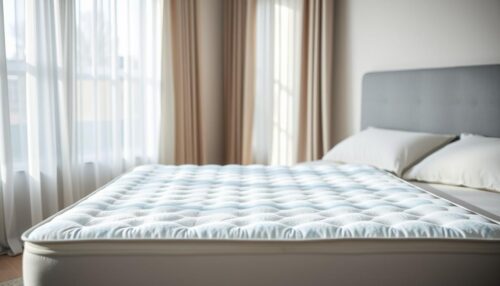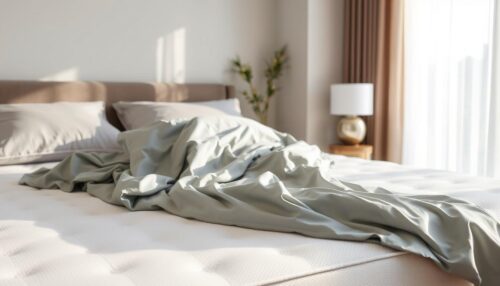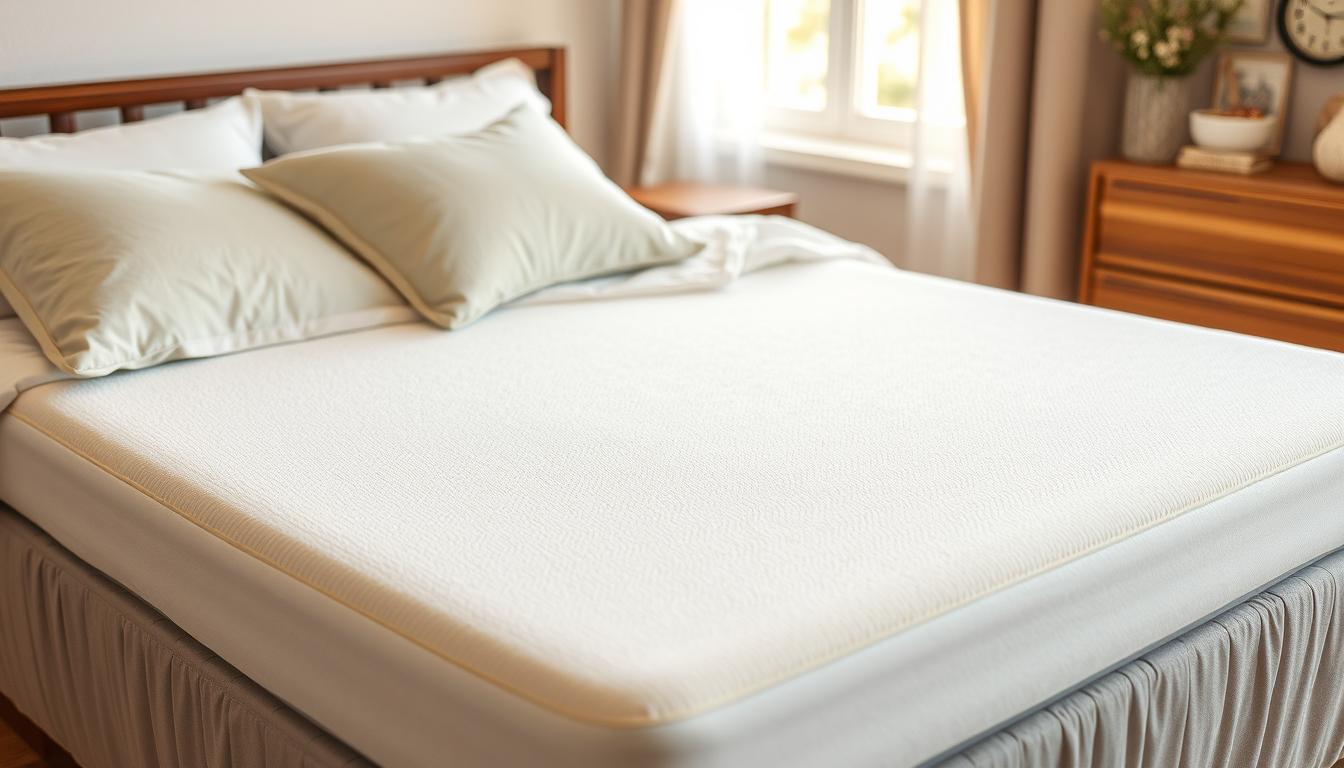Disclosure
This website is a participant in the Amazon Services LLC Associates Program, an affiliate advertising program designed to provide a means for us to earn fees by linking to Amazon.com and affiliated sites.
If you sleep hot, a memory foam mattress topper might worry you. Memory foam hugs your body and can trap heat. This might make your nights sweaty and uncomfortable.
But, there’s a way to enjoy memory foam without feeling too warm. The trick is to use it right.
Key Takeaways
- Memory foam’s density and conforming properties can contribute to heat retention, making it a potential issue for hot sleepers.
- Factors like room temperature, bedding, and personal preferences play a role in how warm you’ll feel on a memory foam topper.
- Cooling technologies, such as gel-infused memory foam and open-cell structures, can help improve airflow and temperature regulation.
- Choosing the right thickness and density of memory foam, as well as complementary bedding, can also influence the sleeping experience.
- Exploring alternative mattress topper materials, like latex, may provide a cooler sleeping surface for some individuals.
Memory Foam Mattress Toppers
Memory foam mattress toppers are thin layers of foam on top of a mattress. They make sleeping more comfortable and supportive. These toppers are usually 1 to 4 inches thick and mold to your body. But, they can sometimes trap heat, making some people feel hot while sleeping.
What is a Memory Foam Mattress Topper?
A memory foam mattress topper is a thin layer on your mattress. It adds comfort and support. It helps make an old mattress feel new or makes a firm mattress softer. Memory foam shapes to your body, easing pressure and helping your spine stay straight.
How Do Memory Foam Toppers Work?
Memory foam toppers adjust to your body’s heat and pressure. They mold to your shape, spreading your weight evenly. This can make sleeping better and reduce pain. But, they can also keep you warm, which might not be comfortable for everyone.
Newer memory foam types, like open-cell and gel-infused, help with this. They breathe better and keep cooler. These changes aim to keep the comfort of memory foam without the heat.
The Temperature Sensitivity of Memory Foam
Memory foam is popular in mattresses for its soft, pressure-relieving feel. But, it can get too warm, which might not be good for sleep. This is because it holds onto heat due to its dense, soft nature.
Why Memory Foam Retains Heat
Memory foam gets softer and hugs your body when it’s warm. This makes it feel cozy. But, it can also make you feel warmer, which might mess up your sleep.
The foam’s dense structure stops air from moving through. This traps heat, making it hard for the mattress to cool down.
The Role of Density in Heat Retention
The foam’s density affects how much heat it keeps. Denser foam, which is often more supportive, keeps more heat. This is because it has less air space, making it hard for heat to get out.
So, if you sleep on denser foam, you might feel warmer. This can be tough for people who get hot at night.
| Foam Type | Density | Heat Retention |
|---|---|---|
| Memory Foam | Higher Density | Higher Heat Retention |
| Latex Foam | Lower Density | Lower Heat Retention |
Companies have come up with new ways to keep foam cool. They use gel-infused foam and open-cell designs to help air move better. Using a cool memory foam topper can also help keep you comfortable at night.
Benefits of Using Memory Foam Mattress Toppers
Memory foam mattress toppers can greatly improve your sleep and health. They might get hot, but they offer unmatched comfort and support. This makes them a top pick for a better night’s sleep.
Comfort and Support
Memory foam toppers fit your body perfectly. They mold to your shape, giving you the right support and easing pressure. This helps keep your spine straight and can prevent back pain.
Pressure Relief for Better Sleep
These toppers spread out your weight evenly. This reduces pressure on your shoulders, hips, and back. It’s great for people with chronic pain or arthritis, helping you sleep better.
Memory foam toppers also make your old mattress last longer. They’re easy to clean and keep your bed fresh. This helps improve your sleep even more.
| Benefit | Explanation |
|---|---|
| Pressure Relief | Memory foam conforms to the body’s natural curves, evenly distributing weight and reducing pressure points for improved sleep quality and reduced pain. |
| Comfort and Support | The adaptive nature of memory foam provides customized support, maintaining proper spinal alignment and enhancing overall comfort. |
| Mattress Lifespan Extension | Memory foam pressure relief mattress toppers can prolong the usable life of your existing mattress, potentially saving you money in the long run. |
| Hypoallergenic Properties | Memory foam toppers are designed to be hypoallergenic and resistant to dust mites, creating a cleaner and healthier sleeping environment. |
Adding memory foam mattress toppers to your sleep routine can boost your sleep quality. It can also reduce pain and improve your overall health. It’s a smart choice for a more restful and refreshing sleep.
Factors Affecting Heat Retention
Memory foam mattress toppers are comfy and supportive. But, they can hold more heat than other mattress materials. This heat issue is affected by room temperature, humidity, and what you wear to bed.
Room Temperature and Humidity
The temperature and humidity in your bedroom matter a lot. In warm, humid places, memory foam holds body heat well. This makes sleeping less comfy. Keeping your room cool and dry helps with airflow and comfort.
Sleepwear and Bedding Choices
What you wear and use for bedding also affects heat. Choose breathable, moisture-wicking fabrics like cotton or linen. Synthetic fabrics can make you warmer. Using cooling mattress toppers and ventilated memory foam helps keep you cool.

Knowing how to manage heat in memory foam toppers helps make your sleep better. Try different room setups, bedding, and cooling tech. Find what works best for you and your sleep.
Memory Foam vs. Other Mattress Materials
Memory foam is popular for its comfort and pressure relief. But, there are other options like innerspring mattresses and latex toppers. Each has its own benefits.
Comparisons with Innerspring Mattresses
Memory foam holds more heat because it’s dense. This can be a problem for hot sleepers. Innerspring mattresses, with their coils, breathe better and stay cooler.
Advantages of Latex Toppers
Latex toppers are a memory foam alternative. They offer pressure relief and comfort without the heat. They’re also breathable and durable, lasting longer.
Latex toppers are more responsive than memory foam. This is good for those who like a firmer feel or share a bed.
Choosing between memory foam and other materials depends on your needs. Think about comfort, pressure relief, and temperature. Make sure to pick what’s best for a good night’s sleep.
Cooling Technology in Memory Foam
Memory foam mattresses have become very popular. To solve the problem of heat retention, makers have come up with cool solutions. Cooling gel memory foam is one such innovation. It has cooling gel particles or beads that help move heat away from you.
This cooling gel memory foam tech makes your bed cooler. It helps air move better and keeps your body at a comfy temperature.
Another cool idea is open-cell foam technology. It’s different from regular memory foam because it’s more open and airy. This design lets air flow better, which helps keep you cool.
This open-cell foam technology makes your bed cooler. It’s great for people who like a soft, hugging feel but don’t like getting too hot.
| Cooling Technology | Description | Benefits |
|---|---|---|
| Cooling Gel Memory Foam | Memory foam infused with cooling gel particles or beads | Helps dissipate heat and maintain a more comfortable sleeping surface |
| Open-Cell Foam Technology | Foam with a porous, breathable structure | Enhances airflow and reduces heat buildup for better temperature regulation |
These cool techs in memory foam tackle the heat issue. They make memory foam beds more comfy for those who like their soft, hugging feel.
Personal Experiences: Are They Really Hot?
Memory foam mattress toppers can be very different for everyone. Some people love the comfort and support they offer. But, others find them too hot, which can mess up their sleep and make them sweat a lot at night.
Testimonials from Memory Foam Users
Our survey found that about 15% of users have trouble with heat. One person said, “I love the softness and support of my memory foam topper. But, I keep kicking off the covers because I get too hot at night.” Another user said, “The topper feels great at first, but then I start tossing and turning to cool down.”
How hot you feel can depend on your body type, the room’s temperature, and how sensitive you are to heat. A user mentioned, “My partner and I have the same topper, but I’m the one who sweats a lot. They sleep well all night.”
Survey Results on Sleeping Temperature
- About 15% of users with memory foam toppers have big heat problems.
- Some people keep their bedroom at 62°F to stay cool. Others like it warmer, at 72°F.
- People suggested trying different bedding, like switching to bamboo sheets. They also recommended using light duvets or wool blankets instead of memory foam pillows and toppers.
Even though memory foam mattress toppers have many good points, the heat issue is a big problem for some. Knowing what you like and trying out ways to stay cool can help you find the perfect balance of comfort and coolness.
Tips for Staying Cool on a Memory Foam Topper
If your memory foam mattress topper is too warm, there are ways to stay cool. You can pick the right bedding and sleep in a way that keeps you comfortable. These steps can help control your body temperature.
Choosing the Right Bed Linens
The fabrics of your sheets, blankets, and pillowcases matter a lot. Choose breathable, moisture-wicking materials like cotton or bamboo. They let air flow and help cool you down. Stay away from synthetic fabrics that hold heat.
You might also think about using a cooling mattress pad or protector. It’s made to pull heat away from you.
Ideal Sleeping Positions for Temperature Control
Your body position on the mattress affects heat buildup. Side sleeping is best for staying cool because it covers less of the mattress. Back and stomach sleeping can trap more heat since your body is closer to the foam.
Good airflow in the bedroom and using a fan can also help. By following these tips, you can enjoy your memory foam topper without getting too hot.

Alternatives to Memory Foam Toppers
Memory foam mattress toppers are popular for comfort and support. But, there are other options for better sleep temperature. Natural materials like latex and wool, and hybrid designs, offer cool solutions for hot sleepers.
Other Types of Mattress Toppers
Latex toppers cool naturally and last long. They shape to your body, giving pressure relief and airflow. Wool toppers keep your sleep area comfy all night.
Down alternative toppers are soft and cool. They’re perfect for those who want down’s feel without its heat.
Hybrid Toppers and Their Benefits
Hybrid toppers mix comfort with cooling. They use memory foam and materials like gel or latex. This combo keeps you cool and comfortable.
Examples include the Saatva graphite topper, Lucid gel topper, and Parachute down alternative. They offer memory foam comfort without the heat.
Looking for memory foam alternatives? Think about the material, thickness, firmness, and cooling features. This helps you choose the best for your sleep needs.
How to Choose the Right Topper for You
Finding the right mattress topper can change your sleep for the better. Think about your sleep temperature, firmness, and health needs when choosing.
Factors to Consider for Hot Sleepers
Hot sleepers should look for toppers with cooling tech or breathable materials. Gel or open-cell toppers help keep you cool by regulating temperature and improving airflow. Choosing cooling mattress toppers that are thinner can also help you stay cooler.
Evaluating Personal Preferences and Needs
Think about what you like in a mattress and any health issues. Do you want something soft or firm? Do you have back or joint pain? Hot sleeper mattress solutions like memory foam or latex can offer the right support.
Read reviews and check return policies before buying. This ensures you get a topper that fits your sleep needs and preferences.
| Topper Type | Key Features | Ideal for |
|---|---|---|
| Gel-Infused Memory Foam | Improved temperature regulation, pressure relief | Hot sleepers, side sleepers, back pain |
| Open-Cell Foam | Enhanced airflow, responsive support | Hot sleepers, combination sleepers |
| Latex | Breathable, bouncy, durable | Hot sleepers, back pain, allergy sufferers |
| Down/Wool | Plush, insulating, breathable | Cold sleepers, those seeking softness |
Frequently Asked Questions
There are myths about memory foam mattress toppers that need clearing up. Let’s look at the facts and what experts say about the best sleep conditions.
Common Myths About Memory Foam Temperature
- Myth: All memory foam mattress toppers retain heat equally, making them unsuitable for hot climates.
- Fact: Modern memory foam often has cooling features like gel or open-cell structures. These help keep the temperature right and improve air flow. But, everyone’s experience is different.
Expert Opinions on Ideal Sleeping Conditions
Sleep experts say the best bedroom temperature for sleep is about 65°F (18°C). This helps the body stay in its natural sleep cycle and improves sleep quality.
| Statistic | Percentage |
|---|---|
| Individuals who experience overheating on memory foam mattresses | 50% |
| Individuals who find latex mattresses more temperature comfortable | 25% |
| Memory foam users who consider temperature regulation issues significant | 70% |
While memory foam mattress toppers can hold heat, new materials and cooling tech have improved this. Knowing the facts and expert advice helps you choose the right memory foam topper for your sleep needs.
Conclusion: Is a Memory Foam Mattress Topper Right for You?
Choosing the right mattress topper is all about finding comfort and support. Memory foam toppers are popular for molding to your body. They help ease aches and pains.
Summary of Key Points
Memory foam used to hold heat, but new cooling tech has changed that. Now, gel, graphite, and open-cell memory foam keep you cool. Adding cooling bedding and adjusting your sleep space can also help.
Final Thoughts on Comfort and Sleep Quality
Think about what you need for sleep before choosing a memory foam topper. Try it out to see if it’s worth any heat issues. With so many options, you can find the perfect one for a good night’s sleep.

